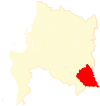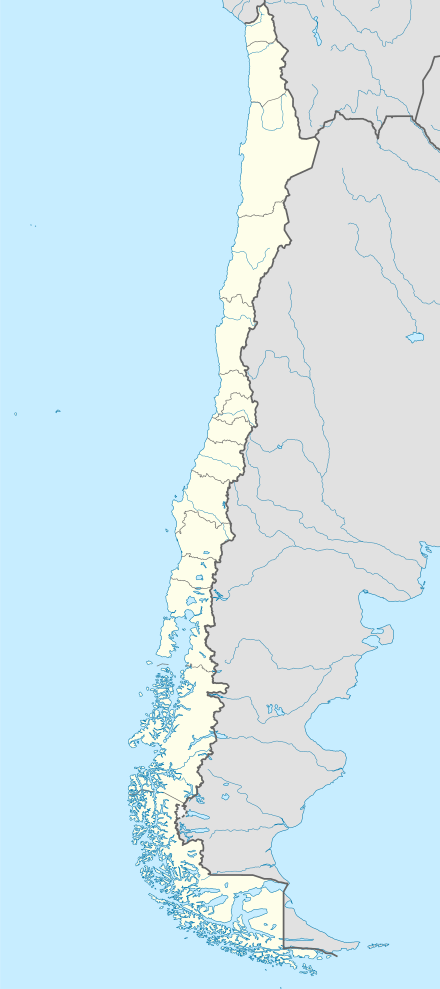Alto Bío Bío
| Alto Bío Bío | ||||
|---|---|---|---|---|
| Commune | ||||
|
Ralco Museum | ||||
| ||||
| Coordinates: 38°03′S 71°19′W / 38.050°S 71.317°WCoordinates: 38°03′S 71°19′W / 38.050°S 71.317°W | ||||
| Country | Chile | |||
| Region | Bío Bío | |||
| Province | Bío Bío | |||
| Alto Bío Bío | 25 August 2003 | |||
| Government[1] | ||||
| • Type | Municipality | |||
| • Alcalde | Félix Vita Manqueti (PPD) | |||
| Area[2] | ||||
| • Total | 2,124.6 km2 (820.3 sq mi) | |||
| Elevation | 973 m (3,192 ft) | |||
| Population (2012 Census)[3] | ||||
| • Total | 6,081 | |||
| • Density | 2.9/km2 (7.4/sq mi) | |||
| • Urban | 1,094 | |||
| • Rural | 5,933 | |||
| Time zone | UTC-4 (CLT [4]) | |||
| • Summer (DST) | UTC-3 (CLST [5]) | |||
| Area code(s) | country 56 + city 43 | |||
| Website | Municipality of Alto Bío Bío | |||
Alto Bío Bío is a Chilean commune located in the Bío Bío Province, Bío Bío Region. The commune spans an area of 2,124.6 km2 (820 sq mi).[2]
History
Mapuche6 worship in Alto Bíobío, with the presence of the President Michelle Bachelet. Museum pehuenche in Ralco, commune of Alto Bíobío.
The commune was created August 25, 2003, separating the southeast portion from the existing Santa Bárbara commune. The capital is in Ralco, Chile.
Alto Bío Bío, differently than how it happens now, during centuries was marked for silence, or better said, a simmering activity that did not arrive to the ears of those in the valley.
The small amount of literature that exists barely mentions the zone and the indigenous population, los pehuenches. The more serious and recent approximations began being written in small chapters around the middle of the 18th century. The installation of a fortified line, associated with the evangelical activities of the catholic missionaries, that were from Rucalhue, were passing through Villucura and Santa Barbara. The origin of the indigenous is one motive of several theories, however there is nothing concrete.
More causes in the Antuco zone (several dozen kilometers north) where strong commercial activity was realized between the criollos and pehuenches. The travel journals of the polish naturalist Ignacio Domeyko7 and the Bavarian artist Mauricio Rugendas relate who took the first pictures of the indigenous population.
As we were saying, the tranquility of the zone was interrupted by the Chilean army's manhunts at the beginning of the 19th century. The manhunts of the Chilean army montoneros8, a leftist urban guerrilla group, that were still loyal to the Spanish Kingdom or of the rustling bandits that devastated the homes of the criollos in the plains (the Pincheira brothers wrote a few of the chapters in Alto Bio Bío).
One hundred years later they went to the events of Ránquil, the eastern most part of the mountain range, where a national working revolt took place. This took place in this zone, with a tragic number of deaths.
Demographics
According to the 2002 census of the National Statistics Institute, Alto Bío Bío had 7,027 inhabitants; of these, 1,094 (15.6%) lived in urban areas and 5,933 (84.4%) in rural areas. The population grew by 31.2% (1,671 persons) between the 1992 and 2002 censuses.[3]
Administration
As a commune, Alto Bío Bío is a third-level administrative division of Chile administered by a municipal council, headed by an alcalde who is directly elected every four years. The 2008-2012 alcalde is Félix Vita Manqueti (PPD).[1]
Within the electoral divisions of Chile, Alto Bío Bío is represented in the Chamber of Deputies by Juan Lobos (UDI) and José Pérez (PRSD) as part of the 47th electoral district, (together with Los Ángeles, Tucapel, Antuco, Quilleco, Santa Bárbara, Quilaco, Mulchén, Negrete, Nacimiento, San Rosendo and Laja). The commune is represented in the Senate by Victor Pérez Varela (UDI) and Mariano Ruiz -Esquide Jara (PDC) as part of the 13th senatorial constituency (Bío Bío-Coast).
References
- 1 2 "Asociación Chilena de Municipalidades" (in Spanish).
- 1 2 "National Statistics Institute" (in Spanish). Archived from the original on 15 July 2010. Retrieved 28 July 2010.
- 1 2 "Territorial division of Chile" (PDF). Archived from the original (PDF) on 14 November 2010. Retrieved 4 November 2010.
- ↑ "Chile Time". WorldTimeZones.org. Archived from the original on 13 July 2010. Retrieved 2010-07-28.
- ↑ "Chile Summer Time". WorldTimeZones.org. Archived from the original on 2007-09-11. Retrieved 2010-07-28.
6. “The Mapuche in Modern Chile: A Cultural History”. Crow, Joanna. 2012. 2017-03-06.
7. “OF CONQUEST AND CIVILIZATION: IGNACIO DOMEYKO AND THE INDIAN QUESTION IN CHILE.” Arreola, Pablo-Raul. 1999, Polish Review, Volume 44, Issue 1, starting on page 69. 2017-03-06.
8. “The militant song movement in Latin America”. Lanham, Maryland: Lexington Books, 2014, 1 online resource., English. Contributor – Vila, Pablo 1952 – editor. 2017-03-06.
External links
- (in Spanish) Municipality of Alto Bío Bío


